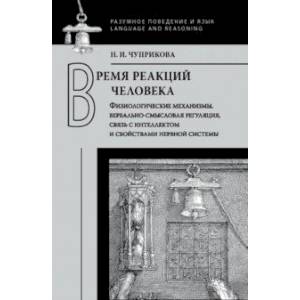The time of human reactions. Physiological mechanisms, verbal-semantic regulation, communication with intelligence
Please sign in so that we can notify you about a reply
The articles presented in the book implement the methodology of an objective physiological approach to the study of the mechanisms of conscious arbitrary reactions of a person, the time of which (BP) is measured in experiments. The processes of organizing reactions are described in the concepts of temporary nervous ties, excitement and inhibition, their generalization and concentration, interaction and struggle for access to the final motorways.
In the center of the discussion, the physiological role of preliminary verbal instructions, the content of which initiates those psychophysiological processes, the course of the course of which is measured in the experiment. The facts indicate that in a situation of simple reaction and simple reactions of distinguishing and choice, the instruction creates in the brain a state of pre -launch integration in the form of a system of open and closed paths. It precedes the supply of launch stimuli and leads to a reduction in BP to some signals and to the blockage of reactions to others. The approach to the mechanisms of BP implemented in the book is inscribed in the context of the general Pavlovsk theory of higher nervous activity, including the interaction of the first (sensory-perceptual) and second (verbal-semantic) signaling systems inherent in a person.
The incompatibility of the realized approach to the study of BPs with theoretical models of BP, developed as part of a "computer metaphor" and based on a hypothetical idea of consistent or parallel stages of stimulus information is discussed. The actual data on the termination of the growth of VP distinguishing and choice is summarized after the number of alternative signals reaches the number of 7 ± 2. The commonality of the physiological causes of this phenomenon and the causes of phenomena of limited attention and short -term memory are discussed.
The connection of individual differences of BP with the properties of lability, mobility and concentration of nervous processes and intellect is considered. The view is justified that the connection of BP and IQ is based on the community of many physiological mechanisms that determine both the effectiveness of mental activity and the larger or lower value of BP.
The book is addressed to psychologists, physiologists, methodologists of the sciences of a person, specialists in modeling mental processes and artificial intelligence
In the center of the discussion, the physiological role of preliminary verbal instructions, the content of which initiates those psychophysiological processes, the course of the course of which is measured in the experiment. The facts indicate that in a situation of simple reaction and simple reactions of distinguishing and choice, the instruction creates in the brain a state of pre -launch integration in the form of a system of open and closed paths. It precedes the supply of launch stimuli and leads to a reduction in BP to some signals and to the blockage of reactions to others. The approach to the mechanisms of BP implemented in the book is inscribed in the context of the general Pavlovsk theory of higher nervous activity, including the interaction of the first (sensory-perceptual) and second (verbal-semantic) signaling systems inherent in a person.
The incompatibility of the realized approach to the study of BPs with theoretical models of BP, developed as part of a "computer metaphor" and based on a hypothetical idea of consistent or parallel stages of stimulus information is discussed. The actual data on the termination of the growth of VP distinguishing and choice is summarized after the number of alternative signals reaches the number of 7 ± 2. The commonality of the physiological causes of this phenomenon and the causes of phenomena of limited attention and short -term memory are discussed.
The connection of individual differences of BP with the properties of lability, mobility and concentration of nervous processes and intellect is considered. The view is justified that the connection of BP and IQ is based on the community of many physiological mechanisms that determine both the effectiveness of mental activity and the larger or lower value of BP.
The book is addressed to psychologists, physiologists, methodologists of the sciences of a person, specialists in modeling mental processes and artificial intelligence
Category:
- Category:Medical Books
ISBN:
ISBN:978-5-90717-62-4
No reviews found
